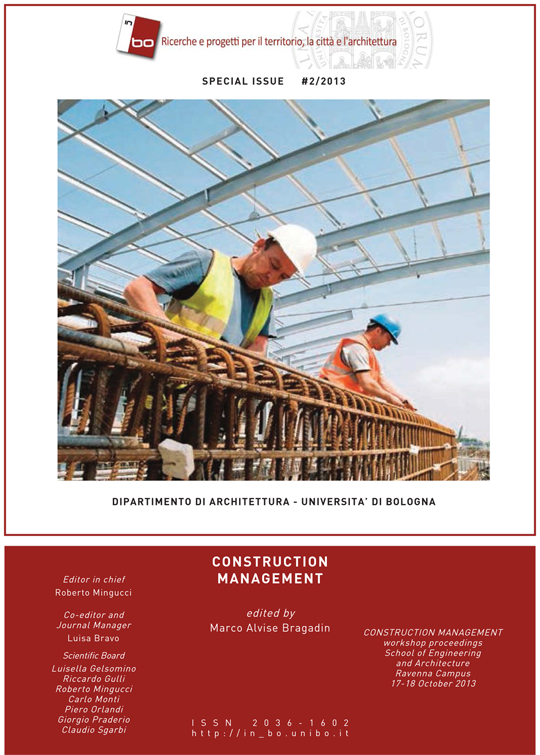REPNET: ottimizzazione della programmazione dei lavori per i progetti di costruzione
DOI:
https://doi.org/10.6092/issn.2036-1602/4054Parole chiave:
construction management, processo edilizio, metodi reticolari, programmazione risorse, programmazione location-basedAbstract
La gestione della fase esecutiva del processo edilizio, Construction Management, ha come processo fondamentale la pianificazione ed il controllo. In pratica la programmazione dei lavori è spesso realizzata tramite tecniche reticolari come il PDM, tuttavia ricercatori ed operatori ritengono che le tecniche reticolari non siano del tutto adeguate per la costruzione, in quanto non sono focalizzate sull’impiego delle risorse ed il loro flusso nel progetto. Si propone quindi un metodo di programmazione che ottimizzi la schedulazione delle risorse, il REPNET, che è una procedura euristica basata su di un reticolo PDM organizzato in un piano risorse–spazio e presentato con la tecnica flow-line. Il REPNET procede alla programmazione delle risorse ottimizzandone sia l’impiego che il flusso del lavoro, come presentato con un semplice esempio.Riferimenti bibliografici
Arditi D., Tokdemir O. B., Suh K. (2001) Scheduling System for repetitive unit construction using line-of-balance technology. Engineering, Construction and Architectural Management 8(2), 90 – 103
Arditi D., Tokdemir O. B., Suh K. (2002) Challenges in Line-of-Balance Scheduling. Journal of Construction Engineering and Management, vol 128(6), 545-556
Bragadin M. A. (2008). La programmazione dei lavori con i metodi reticolari. Ed. Maggioli
Bragadin M. A. (2010). Heuristic Repetitive Activity Scheduling Process for Networking Techniques. Proceedings of the CIB 2010 World Building Congress, Salford Quays, U.K. 1-12
Bragadin M., Kähkönen, K (2011). Heuristic Solution for Resource Scheduling for Repetitive Construction
Projects. Proceedings of the MISBE 2011 CIB Congress, Amsterdam, The Netherlands
El Rayes K., Moselhi O. (1998). Resource-driven scheduling of repetitive activities. Construction Management and Economics, 16, 433-446
Harris R. B., Ioannou P. G. (1998). Scheduling Projects with repeating activities. Journal of Construction Engineering and Management, vol 124(4), 269-278
Kähkönen, K. (1994). Interactive Decision Support System for Building Construction Scheduling. Journal of Computing in Civil Engineering, 8(4), pp. 519-535
Kang L.S., Park I.C. and Lee B. H. (2001). Optimal Schedule Planning for Multiple, Repetitive Construction
Process. Journal of Construction Engineering and Management, 127(5), 382-390
Kenley R., Seppänen O. (2009). Location-Based Management for Construction Projects: part of a new Typology for Project Scheduling Methodologies. Proceedings of the 2009 Winter Simulation Conference, 2563-2570
Kenley R., Seppänen O. (2010). Location-Based Management for Construction. Spon Press, U.K
Koskela L. (1992). Application of New Production Philosophy to Construction. CIFE Technical Report #72, Stanford University, USA, September 1992
Lowe, R. H., D’Onofrio, M. F., Fisk, D.M., Seppanen O. (2012). A Comparison of Location - Based Scheduling with the traditional Critical Path Method. 2012 Annual meeting of American College of Construction Lawyers
Märki, F., Fischer, M., Kunz; J. and Haymaker, J. (2007). Decision Making for Schedule Optimization. Stanford University, CIFE Technical Report #169
Moselhi O., Hassanein A. (2004). Discussion of Network Creation and development for Repetitive-Unit Projects. Journal of Construction Engineering and Management, 130(4), 613-614
Selinger S. (1980). Construction planning for linear projects. Journal of Construction Division American Society Civil Engineers, 106(2), 195-205
Steyn H. (2000). An investigation into the fundamentals of critical chain project scheduling International. Journal of Project Management, 19(2000), 363-369
Tommelein I. D., Riley D. R. Howell G.A. (1999). Parade Game: Impact of work flow variability on trade performance. Journal of Construction Engineering and Management, vol. 125, n. 5/1999
Vanhoucke M. (2006). Work Continuity Constraints in Project Scheduling. Journal of Construction Engineering and Management, 132 (1), 14-25
Yang I. T., Ioannou P. G. (2001). Resource-driven scheduling for repetitive projects: a pull-system approach. Proceedings of the 9th International Group for Lean Construction Conference, Singapore, 6-8 August, 365-377
Yi K.J., Lee H. and Choi Y.K. (2002). Network Creation and development for Repetitive-Unit Projects. Journal of Construction Engineering and Management, 128(3), 257-264
Downloads
Pubblicato
Come citare
Fascicolo
Sezione
Licenza
Copyright (c) 2013 Marco Alvise Bragadin, Kalle Kahkonen
I diritti d'autore e di pubblicazione di tutti i testi pubblicati dalla rivista appartengono ai rispettivi autori senza alcuna restrizione.
Questa rivista è distribuita con licenza Creative Commons Attribuzione - Non commerciale 4.0 Internazionale (licenza completa).
Vedere anche la nostra Open Access Policy.
Metadati
Tutti i metadati dei materiali pubblicati sono rilasciati in pubblico dominio e possono essere utilizzati da ognuno per qualsiasi scopo. Questi includono i riferimenti bibliografici.
I metadati – riferimenti bibliografici inclusi – possono essere riutilizzati in qualsiasi formato senza ulteriori autorizzazioni, incluso per scopo di lucro. Chiediamo cortesemente agli utenti di includere un collegamento ai metadati originali.






